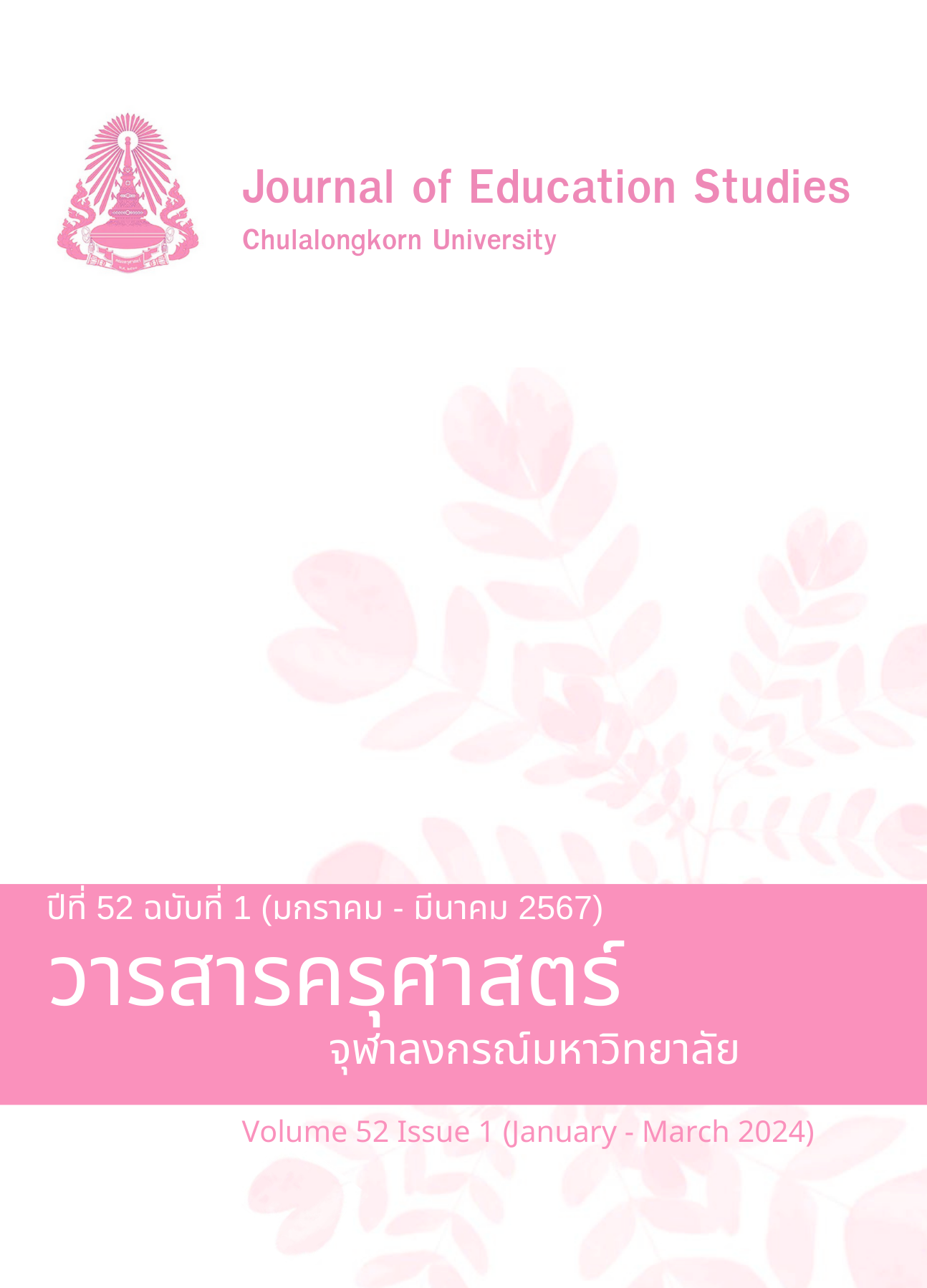Development of a BCG economy model-integrated STEM learning activities
DOI:
https://doi.org/10.14456/educu.2024.8Keywords:
STEM education, STEM-BCG, Professional development, In-service teachersAbstract
BCG economy model-integrated STEM education has been widely promoted as
a significant driver of Thai education, with its three dimensions of bioeconomy, circular economy, and green economy serving as the main features of integrated STEM activities in promoting learners’ competencies. This academic article provides a model for BCG economy model-integrated STEM learning activities centered around the theme “The Right Cup! for Valentine’s Day”. The purpose of this BCG model-integrated activity was to create the formulation of a drink which was made from local ingredients. The seven steps of BCG economy model-integrated STEM learning activities include: 1) identifying the problem; 2) familiarizing the nature of innovation; 3) analyzing the potential of innovation in practical use; 4) linking innovation to stakeholders; 5) defining the steps and outcomes throughout the task; 6) testing and evaluating the innovation; and 7) reflecting on the learning for innovation adjustment. These steps promote integration among the learners’ community, economy, and local innovation, ultimately enabling learners to meaningfully apply STEM-BCG to their lives.
References
ภาษาไทย
กรกนก เลิศเดชาภัทร และชาตรี ฝ่ายคำตา. (2564). กระบวนการออกแบบเชิงวิศวกรรม: กลไกขับเคลื่อนกิจกรรมสะเต็ม. วารสารหน่วยวิจัยวิทยาศาสตร์ เทคโนโลยี และสิ่งแวดล้อมเพื่อการเรียนรู้, 12(2), 356-368.
ชาตรี ฝ่ายคำตา ณภัทร สุขนฤเศรษฐกุล สหรัฐ ยกย่อง พงศธร ปัญญานุกิจ ธาฤชร ประสพลาภ กนกเทพ เมืองสง จินทิมา นิลอุบล และณมน น่วมเจริญ. (2565). แนวคิดสะเต็มบีซีจีเพื่อการศึกษา. วารสารหน่วยวิจัยวิทยาศาสตร์ เทคโนโลยี และสิ่งแวดล้อมเพื่อการเรียนรู้, 13(2), 344-362.
ชุติมา วิชัยดิษฐ และชาตรี ฝ่ายคำตา. (2564). การรับรู้เกี่ยวกับความรู้ในเนื้อหาผนวกวิธีสอนสะเต็มศึกษาของครูวิทยาศาสตร์. วารสารศึกษาศาสตร์ มหาวิทยาลัยนเรศวร, 23(2), 152-168.
ปรียาภรณ์ คงแก้ว และปนัฐษรณ์ จารุชัยนิวัฒน์. (2563). สภาพและปัญหาของครูในการจัดประสบการณ์การเรียนรู้แบบสะเต็มศึกษาสำหรับเด็กวัยอนุบาล. วารสารศึกษาศาสตร์ มหาวิทยาลัยศิลปากร, 18(1), 281-300.
ปัฐมาภรณ์ พิมพ์ทอง. (2564). การจัดการเรียนรู้สะเต็มศึกษา. วิสต้า อินเตอร์ ปริ้นท์.
วุฒิชัย ภู่ดี. (2566). การพัฒนาสมรรถนะการรวมพลังทำงานเป็นทีมของผู้เรียน โดยใช้การจัดการเรียนรู้ตามแนวทางสะเต็มศึกษาแบบ 6E ร่วมกับโมเดลเศรษฐกิจบีซีจี สำหรับนักเรียนชั้นมัธยมศึกษาปีที่ 1 โรงเรียนชุมชนบ้านคำพอกท่าดอกแก้ว. วารสารวิทยาศาสตร์และวิทยาศาสตร์ศึกษา, 6(1), 105-199.
สิรินภา กิจเกื้อกูล. (2558). สะเต็มศึกษา. วารสารศึกษาศาสตร์ มหาวิทยาลัยนเรศวร. 17(2) 201-207.
สำนักงานพัฒนาวิทยาศาสตร์และเทคโนโลยีแห่งชาติ [สวทช.]. (2563). โมเดลเศรษฐกิจใหม่ BCG. https://www.nstda.or.th/home/knowledge_post/bcg-by-nstda/
ภาษาอังกฤษ
Afriana, J., Permanasari, A., & Fitriani, A. (2016). Project based learning integrated to stem to enhance elementary school’s students scientific literacy. Journal Pendidikan IPA Indonesia, 5(2), 261-267.
Bybee, R. W. (2013). The case for STEM education: Challenges and opportunities. NSTA.
Faikhamta, C., Lertdechapat, K., & Prasoblarb, T. (2020). The impact of a PCK-based professional development program on science teachers’ ability to teaching STEM. Journal of Science and Mathematics Education in Southeast Asia, 43.
Faikhamta, C., Srisarakorn, S., & Suknarusaithagul, N. (2024). Design-based STEM-BCG Learning for Sustainable Development: Design, Practices, and Outcomes. In Cross-disciplinary STEM Learning for Asian Primary Students (pp. 84-108). Routledge.
Haryadi, R., & Pujiastuti, H. (2022). Enhancing Pre-service Physics Teachers' Higher-Order Thinking Skills Through STEM-PjBL Model. International Journal of STEM Education for Sustainability, 2(2), 156-171.
Moore, T. J., Bryan, L. A., Johnson, C. C., & Roehrig, G. H. (2021). Integrated STEM education. In STEM Road Map 2.0: A Framework for Integrated STEM Education in the Innovation Age (pp. 25-42). Taylor and Francis.
Roehrig, G. H., Dare, E. A., Ring-Whalen, E., & Wieselmann, J. R. (2021). Understanding coherence and integration in integrated STEM curriculum. International Journal of STEM Education, 8, 1-21.
Srikoom, W., Faikhamta, C., & Hanuscin, D. (2018). Dimensions of effective STEM integrated teaching practice. K-12 stem Education, 4(2), 313-330.
Stehle, S. M., & Peters-Burton, E. E. (2019). Developing student 21st century skills in selected exemplary inclusive STEM high schools. International Journal of STEM Education, 6(1), 1-15.
Trairat, P., Somkun, S., Kaewchum, T., Suriwong, T., Maneechot, P., & Kiatsiriroat, T. (2023). Biogas-powered small power generation system designed for the agricultural sector to support the BCG model in Thailand. Engineering & Applied Science Research, 50(6), 548-560.
Walker, M. (2015). Imagining STEM higher education futures: Advancing human well-being. Higher Education, 70, 417-425.
Downloads
Published
How to Cite
Issue
Section
License

This work is licensed under a Creative Commons Attribution-NonCommercial-NoDerivatives 4.0 International License.




